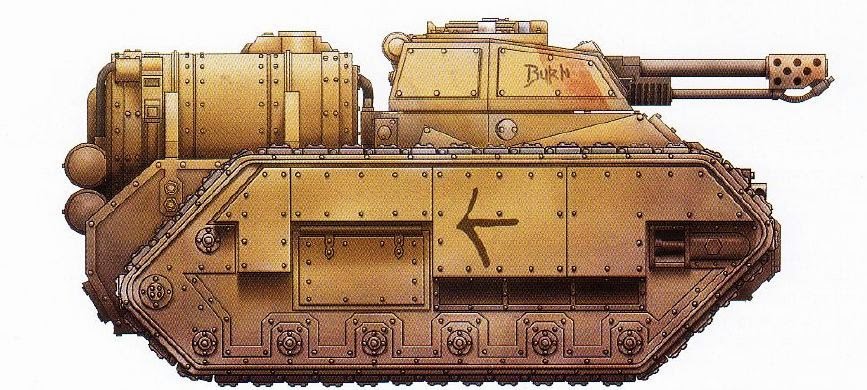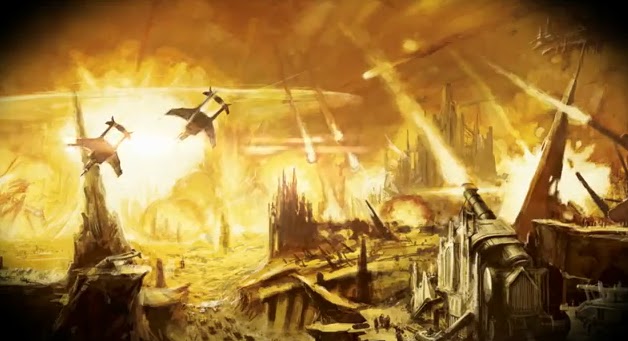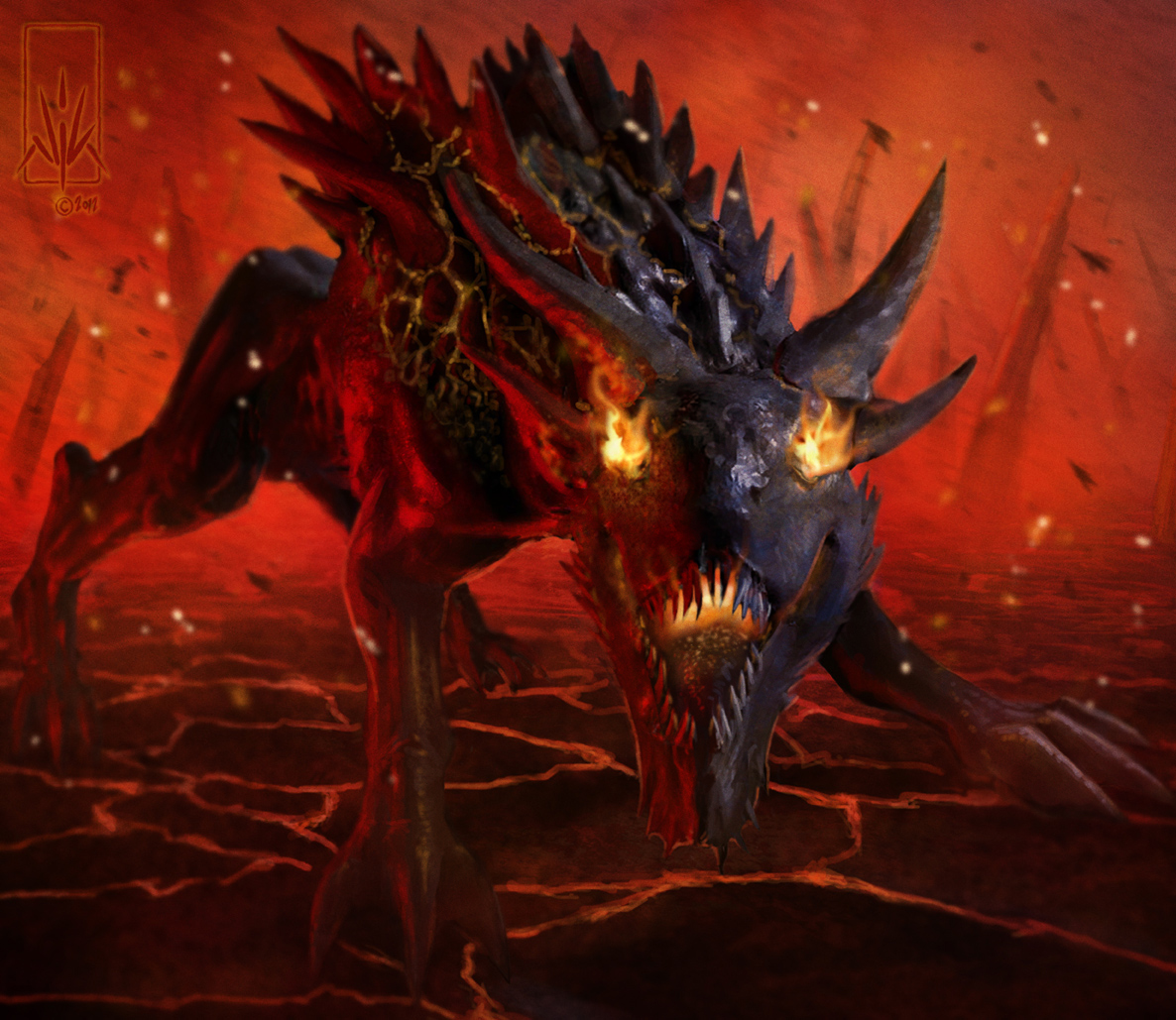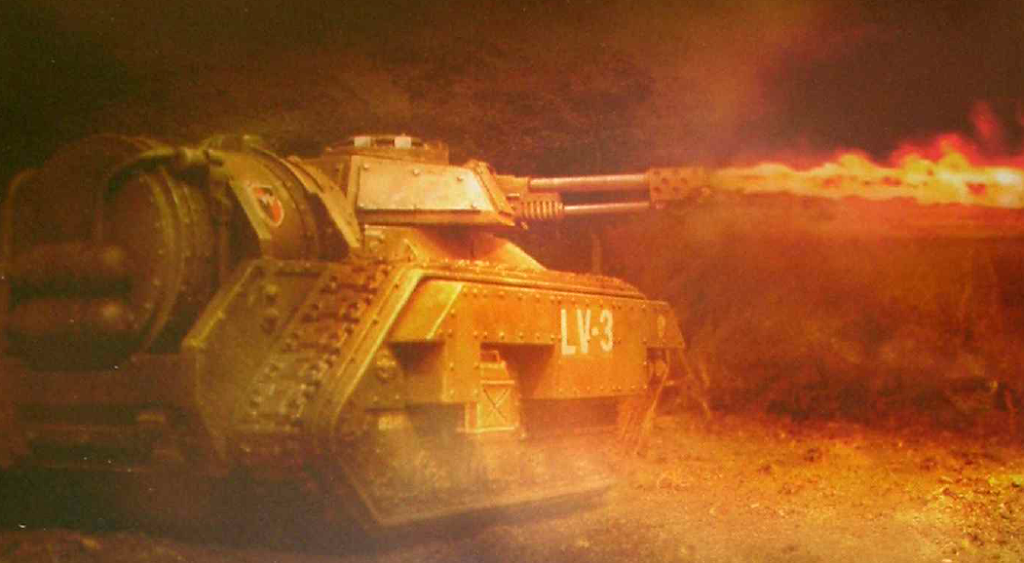40K Tactics: Astra Militarum – Hellhounds

“Burninating the countryside – burninating all the people” ~Strongbad Today is all about the Hellhound!
Howdy howdy ho everyone and welcome to my latest in the long-running Astra Militarum Tactica series! I have eagerly awaited the chance to review some of my favourite tanks employed by Imperial forces, the Hellhounds, and that day has finally come.
While each of the three variants is distinct in regards to what their preferred targets are, all of them are almost identical in terms of role and profile that comparing each variant in the one article is not only logical but also sensible. While the incredible points reductions to most Leman Russ variants has in turn reduced the comparative value of the Hellhound tanks, that 7th Edition mostly revolves around mobility and clearing out opposing Objective Secured units gives these fast vehicles a solid place in many competitive army lists. I hope you enjoy this article!
Note that this can be considered a review of each Hellhound variant, including the Hellhound, Bane Wolf and Devil Dog.
Overview
As a more heavily armoured form of the Chimera chassis, the Hellhound class of tanks trade any form of transport capacity for heavier firepower using chemical or incendiary munitions. The readjustment of space previously used for ferrying infantry squads allows Hellhounds to power their engines and weaponry to a degree a standard tank using the Chimera chassis would be incapable of. Of course, Hellhounds wouldn’t be what they are if it didn’t come at a physical manufacturing cost and that certainly reflects on the table top with Hellhounds being both far less accessible and roughly twice as expensive to field as Chimeras before the unit attached to the latter is accounted for. As each Hellhound shares the Chimera chassis, the profile can be a bit deceiving; given that they are designed for closer battles and clearing defenders from buildings or ruins commonly found in tightly packed city environments, the boosted side AV12 is both a fitting survivability boost and a very useful one at that. Otherwise, the stats and defences of a Hellhound are what you would expect; front AV12 and rear AV10, Ballistic Skill 3 crew and a total of three hull points. Basically, they are still fodder for Wave Serpents, autocannons, missile pods and so on, while close combat is still anathema for them just as it is for almost any other vehicle. For any weapon that doesn’t use a template, Hellhounds are just as inaccurate as any other Imperial Guard unit, while their traditional role as close quarters, independent objective sweepers means they are likely to draw a lot of unwanted attention.
While I’m not particularly a fan of the term and think it applies more so to Rough Riders than anything else as far as the Astra Militarum codex is concerned, I do consider Hellhound variants to be “glass cannons” to a degree as their damage output and mobility are insane but they are comparatively fragile for their cost when put beside equivalently priced Leman Russ tanks. Their mediocre armour values aside, what really provides good incentives to employ Hellhounds is their sheer mobility which is perfectly suited for 7th Edition; as Fast vehicles, Hellhounds can move and fire with impunity or use their increased flat out move distance to cover territory with almost unrivaled speed for an Imperial tank. Their weapons are also suitably devastating to fit the satanic designations of the tanks themselves, with each one possessing a primary and secondary weapon system. The secondary weapon system is similar across each Hellhound variant with three options to choose from, including the free heavy bolter or heavy flamer, and the paid for multi melta. What serves to differentiate each variant from each other, however, is the primary weapon system which is unique to each type of Hellhound. The titular tank that gives the class its namesake possesses a mighty Inferno Cannon, a Strength 6 AP4 Torrent template weapon that Tyranid players would no doubt be familiar with given the Tyrannofex’s Acid Spray is identical in every way. This is easily the best of the three weapons in a 7th Edition context where the occupants of open-topped transports suffer D6 automatic hits when the transport itself is struck by a template weapon, Objective Secured troops choice and mobile scoring units are in their prime, and Ignores Cover is still one of the best special rules in the game. The Inferno Cannon annihilates anything with a 4+ armour save with ease, while the Torrent special rule allows you to maximise your hits by a huge amount while also allowing the Hellhound itself to fire without nearly as much fear of reprisal.
While the Inferno Cannon’s uses against vehicles are most certainly limited, it is the Bane Wolf’s Chem Cannon that classifies as truly useless against anything with an armour value as it is a Poisoned weapon with a natural Strength 1. That the Chem Cannon always wounds models with a Toughness value on a 2+ and has AP3 to boot makes it by far the deadliest against tightly clustered elite infantry such as Space Marines, though its lack of Torrent means it cannot land anywhere near as many hits as an Inferno Cannon while the Bane Wolf itself has to have close proximity to its target to fire. Considering that vehicles of all kinds barring chariots and walkers want to avoid close combat at all costs, and that 8″ range is also where all melta weapons become absolutely deadly, this makes the Bane Wolf an almost suicidal unit in its application. Still, the first two variants are undeniably anti-infantry platforms and this is where the Devil Dog deserves some love if only because it offers something entirely distinct of the other two. Where a Bane Wolf reads as an inferior Hellhound given that a Strength 6 AP4 template with Torrent almost always beats out the raw damage output of a Poisoned (2+) AP3 regular template, the Devil Dog distinguishes itself from the rest of the pack by providing a devastating Strength 8 AP1 Melta small blast with a hefty 24″ range. If ever you have wanted to annihilate AV13 and AV14 vehicles on the first turn of a game but lacked the long ranged Strength 9 AP2 power provided by lascannons, then surely a blast-based melta weapon with a 24″ melta range mounted on a fast vehicle that can move 12″ and still fire its two weapons should appeal to you. If you go off the long table-edge deployment option on a standard 6×4 gaming table, a Devil Dog that starts on the very edge of the deployment zone and then moves straight forward 12″ will theoretically be able to fire its Melta Cannon at a juicy heavily armoured target and, with a direct hit, be able to benefit from the pseudo Armourbane provided by being within half range of a melta weapon. Still, the inherent inaccuracy and slightly higher cost of the Devil Dog compared to the other variants – and in particular the titular Hellhound itself – does somewhat leave it as a bit of a niche choice, especially once you start comparing each Hellhound variant next to its most analogous Leman Russ sub-type.
This is the main issue with Hellhounds in the current codex and why you will often see players forgo their generally more reliable firepower and impressive mobility which is fantastic in a Maelstrom of War context for the raw durability and potential weaponry per tank that only Leman Russes can provide. This is where my “glass cannon” specification rears its ugly head as Hellhounds are certainly no more durable than a Space Marine Dreadnought in the context of 7th Edition, even with the various defensive buffs that walkers and vehicles in general received. Massed Strength 7 firepower of almost any kind – whether through Eldar Serpent Shields, Imperial (or Chaos) Autocannons or Tau Missile Pods – will annihilate these vehicles in rapid succession, making them overly expensive fodder unless they are well hidden or manage to grab the first turn and a favourable deployment map. Compare this to Leman Russes that are entirely immune to Strength 7 shooting and are really only vulnerable to melta or haywire weapons in addition to the usual close combat attacks and it isn’t difficult to see why they are often preferred over Hellhounds. Still, what works in favour of Hellhounds is that the firepower debate generally favours their side, especially once you consider that templates cannot scatter whatsoever. A Leman Russ Eradicator is ever so slightly cheaper than a Hellhound and offers a weapon with the exact same Strength and AP, but trades the torrent template specifications for a 36″ range large blast instead. Don’t let the vast gulf in initial range fool you; when movement is taken into account, the Hellhound has an effective range of 32″ with its Inferno Cannon, while a Leman Russ Eradicator only receives a mere 10″ more range with an effective range of 42″ when firing its Eradicator Nova Cannon. No matter how important survivability and the likelihood of increased shooting phases to participate in can be, there’s no denying how essential at least some mobility is for Maelstrom of War missions; if you choose not to move out and capture objectives or single out well defended units, your chances of winning are as slim as tabling an opponent that has four Deathwing Land Raiders with 4+ invulnerable saves. It is for these reasons that Hellhound variants still have a place in competitive Astra Militarum army lists, even if you are usually better off investing in Vendettas or the various Forge World flyers to handle anti-air defences.
How to Equip Them
Given how crucial staying mobile is to these inherently short ranged tanks, dozer blades can be considered a near-mandatory upgrade for the Bane Wolf and a good but unnecessary addition to a Hellhound or Devil Dog. This is because the Bane Wolf has an effective range of 20″ when its movement is taken into account, while the Hellhound has a 32″ effective range and the Devil Dog has a 36″ effective range. The huge range disparity between the Bane Wolf and the other two variants and the limit of its actual 8″ shooting range means that it absolutely cannot afford to be immobilized early on and become essentially an overly expensive road-block, while the other two at least can use their primary weapons to provide a decent threat zone of 20″ or more. As such, I also recommend that you take a heavy bolter on a Bane Wolf as the secondary weapon because it will otherwise just be a harmless and scary-looking tank to your opponent for the better part of two turns. While the same principle does apply to the Hellhound as well and especially as you don’t want to waste its huge distance advantage between itself and its targets for the purposes of retaliatory attacks, a heavy flamer isn’t out of place for a fast moving tank that does have some medium ranged damage capabilities. The Devil Dog really should take a multi melta as the secondary weapon to provide it a more reliable chance of actively damaging enemy vehicles or monstrous creatures, especially as its Melta Cannon is very inaccurate given the Ballistic Skill 3 small blast it employs.
Of course, you can get away with a heavy bolter on a Devil Dog as well if you need to save points seeing as it does give you a little extra light anti-tank punch. Just try not to mix multi-meltas with the Hellhound and Bane Wolf and definitely do not use a heavy flamer with a Devil Dog; as nice as versatility can be, for fragile tanks that are by definition very aggressive and fragile it is rarely a good idea to pay for mildly threatening multiple targets rather than focusing on their specific quarry. A Hellhound wastes its Inferno Cannon by using a multi-melta against vehicles and monstrous creatures to a lesser extent, while a Devil Dog’s Melta Cannon is not suited to the super close ranged infantry-destruction a heavy flamer provides – especially as an unlucky scatter can easily see a Devil Dog destroy itself when firing in such tight areas! At least a multi-melta isn’t too bad for a Bane Wolf as you have something to use against enemy transports (which a Bane Wolf is useless against) while you try to close the distance between it and enemy infantry, but mixing the various types of weapons is generally a bad idea on tanks that often only live to see two or three shooting phases if that. Don’t bother with any of the other upgrades; Hellhound variants already face fierce competition from Leman Russes in the current codex and they don’t need to further tip the balance towards the latter by arbitrarily increasing their cost through pointless or unnecessary upgrades.
Best Uses
Before I begin, let me address a common mistake I see made in multiple matches involving vehicles with the Fast type; whether the vehicle in question is a tank or a skimmer, it can fire all weapons at full Ballistic Skill if it moves 6″ and two weapons at full Ballistic Skill if it moves 12″. With that out of the way, let me make it absolutely clear that Hellhound variants are not designed around cautious play; they are there to expose seemingly guarded infantry units (or vehicles in the case of a Devil Dog) and annihilate them swiftly. They are built for speed as befits their canine naming conventions and are thus perfect for Maelstrom of War missions where you need to have at least a handful of units that can zoom around the battlefield and score variable victory points as necessary. Hellhounds used to suffer towards the tail end of 6th Edition as Leman Russ Eradicators and Vanquishers in particular did the same job as their counter-part Hellhound variants performed but traded unnecessary speed for outright survivability and range. In this case, 7th Edition has given this particular adaptation of the Chimera chassis a huge buff regardless of whether you play Maelstrom of War or Eternal War missions seeing as both exploit their high movement for capturing or contesting objectives on the fly. The trick is that Hellhounds typically never survive until the end of the game, but their total 24″ movement a turn including flat out makes them incredibly valuable for what is an otherwise sluggish force in the Astra Militarum. While one could argue a static Astra Militarum list doesn’t worry too much about an opponents’ non-mobile Objective Secured units as they will typically just squash the opponent through weight of fire and claim the objectives in their own half with ease, such army lists are gradually being forced to adapt to the speedy pace of Maelstrom of War missions.
As for which targets each variant prefers, Hellhounds are suited more to dealing with light to medium infantry while dealing with otherwise nasty threats you don’t want to get close to – such as your usual Space Marine squad with krak grenades – at range, while Bane Wolfs do prefer those hardier forces but this obviously comes at much greater risk to their own safety. The Devil Dog is a vehicle hunter by nature but it is also bears situational use for targeting tightly clustered heavy infantry squads such as Deep Striking Terminators or sniping wounds off of monstrous creatures. Ultimately though, the Hellhound is the most adaptable of the three – it can stay at range just like the Devil Dog, but it ignores cover on all wounds its main gun causes like the Bane Wolf, while Strength 6 gives it limited but decent damage potential against light vehicles such as Rhinos or Venoms. It is also the most accurate of the three in terms of average number of hits inflicted due to the Torrent special rule on its Inferno Cannon, meaning it can stay 20″ away (the 12″ Torrent “range” and the 8″ length of a template) and annihilate a row of Ork Trukks or Dark Eldar Venoms while simultaneously dispatching the valuable contents within. The Bane Wolf is only really worthwhile against Space Marines and significantly damaged monstrous creatures but its chosen targets are all capable of destroying it with ease, especially as a non-torrent template cannot really guarantee a large number of hits on enemy units; that it is forced to get so close has seen not an insignificant amount of players emblazon it with the “suicidal” tag. If you are fielding any of these three tanks, field them alone – you don’t want to invest too many points into a vehicle squadron that is designed for close encounters and will get absolutely mauled when charged. The only exception to this rule would be if you are fielding a pair of flyers in the slot such as two Vendettas, as you generally do not want to squadron those whatsoever and thus taking the blow on Hellhounds becomes a more sensible decision.
Thank you all for taking the time to read these collected thoughts on the subject of Hellhounds! While each of the three variants is generally decent in a 7th Edition context, I still feel the most basic variant that is also the name-sake of the trio is the most competitive because it can happily keep at range, is inexpensive and reliable in terms of damage output.
In any case, I hope you enjoyed this latest article and I look forward to reading your thoughts and critiques if you have any for me – we appreciate any and all feedback!





